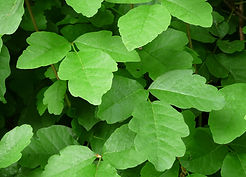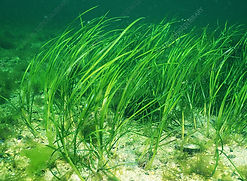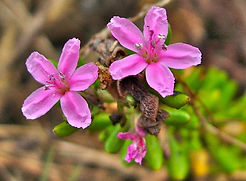

PLANTS OF ORANGE COUNTY
Chaparral
The Chaparral habitat can be characterized by its short woody shrubs, dry soil, warm weather, and is typically seen within the inland hills off the Pacific coast. It is also a habitat unique to the West of North America. Chaparral habitats can be found from Southern Oregon, through California, and down to Northern Mexico. Many of the plant species found in Chaparral habitats are drought-tolerant as the area they thrive in is very dry. However, the hills of Chaparral make for an advantage as the slopes allow rainwater to run and drain quickly through the plant species, not overbearing them with water. Southern California's unique Mediterranean climate makes an ideal habitat for unique Chaparral plant species.
Artemisia californica
Toxicodendron diversilobum
Black Sage
Salvia mellifera
Bush Monkey Flower
Mimulus aurantiacus
California Buckwheat
Eriogonum fasciculatum
California Coffeeberry/Buckthorn
Rhamnus californica
Ceonothus
Ceonothus spp.
Deerweed
Acmispon glaber
(previously Lotus scoparius)
Adenostoma fasciculatum
Quercus berberidifolia
Dodder
Cuscuta californica
Fuchsia-Flower Gooseberry
Ribes speciosum
Hummingbird Sage
Salvia spathacea
Islay/Hollyleaf Cherry
Prunus ilicifolia
Laurel sumac
Malosma laurina
Lemonade Berry
Rhus integrifolia
Hesperoyucca whipplei
Heteromeles arbutifolia
Manzanita
Arctostophylos ssp.
Mountain Mahogany
Cercocarpus spp.
Purple Sage
Salvia leucophylla
Sugar Bush
Rhus ovata
White Sage
Salvia apiana
Wild Cucumber
Marah fabaceus
For more information on the plants above, please click here.
Coastal "Beach" Dune
Coastal Beach Dunes or “Sand Dunes” are dynamic habitats scattered throughout the California coast that are affected by the waves, winds, and tides of the beaches. The dunes of these beaches develop when the sand is being blown by winds in an onshore direction. The sand being carried by the wind then typically settles as dunes due to obstacles that slow the velocity of the wind. Oftentimes, the obstacles are the salt-tolerant plant species that have adapted to thrive in the sand. The beach grasses and shrubs that are seen in Coastal Dune habitats promote sand deposit and stabilize the dune system with their roots, creating a unique relationship between the plant species and their habitat.
Calystegia soldanella
Crystaline Iceplant/Common Iceplant
Mesembryanthemum crystallinum
Beach Bur/Sand Bur
Ambrosia chamissonis
Beach Evening Primrose
Camissonia cheiranthifolia
California Poppy
Eschsholzia californica
Coast Goldenbush
/Menzies' Goldenbush
Isocoma menziesii
Coast Woollyheads
Nemacaulis denudata
Common Yarrow
Achillea millefolium
Atriplex leucophylla
Cortaderia selloana
Dune Buckwheat/Seacliff Buckwheat
Eriogonum parvifolium
Giant Coreopsis
Coreopsis gigantea
Giant Wildrye
Elymus condensatus
Hottentot-fig/Highway Iceplant
Carpobrotus edulis
Hummingbird Sage
Salvia spathacea
Red Sand Verbena
Abronia maritima
Abronia umbellata
Distichlis spicata
Sandcarpet
Cardionema ramosissimum
Sea Cliff Daisy/Cliff Aster
Malacothrix saxatilis
Sea/Seaside Fiddleneck
Amsinckia spectabilis
Sea Rocket
Cakile maritima
Seaside Heliotrope
Heliotropium curvassavicium
Western Wagweed
Ambrosia psilostachya
For more information on the plants above, please click here.
Coastal Sage Scrub
Coastal Sage Scrub habitats can appear on rocky hills along California coastal zones where the plant species have adapted shallow strong roots that help anchor to the cliff and prevent erosion, as well as some drought-tolerance characteristics. The plant species within Coastal Sage Scrub habitats are capable of capturing water from light rain and early morning fog. Another adaptation of these plants include losing their leaves during the summer in response to the hotter, drier season (deciduous plants). Very little of coastal sage scrub has gone undisturbed by invasive species, but few healthy and intact areas of the natural habitat can still be found along the coastal cliffs of the Channel Islands.

Salvia mellifera
Opuntia littoralis
Bladderpod
Peritoma arborea
Bush/Chaparral Mallow
Malacothamnus fasciculatus
Bush Monkeyflowers
Mimulus aurantiacus
California Sagebrush
Artemisia californica
California Scrub Oak
Quercus berberidifolia
Chaparral Yucca
Hesperoyucca whipplei
Baccharis pilularis
Clif Spurge
Euphorbia misera
Coast Brittlebush/Bush Sunflower
Encelia californica
Coast/Menzies' Goldenbush
Isocoma menziesii
Coastal Sage Scrub Oak/
Nuttall's Scrub Oak
Quercus dumosa
Deerweed
Acmispon glaber
Fuchsia-Flower Gooseberry
Ribes speciosum
Cylindropuntia prolifera
Rhus integrifolia
Giant Coreopsis
Coreopsis gigantea
Laurel Sumac
Malosuma laurina
Purple Sage
Salvia Leucophylla
Redberry/Spiny Redberry
Rhamnus crocea
Saw-tooth Goldenbush
Hazardia squarrosa
Toyon/California Holly
Heteromeles arbutifolia
White Sage
Salvia apiana
For more information on the plants above, please click here.
Grassland
California Grasslands is sometimes referred to as “California Coastal Prairies” since the expansive grass fields of this habitat was often seen on the flatter tops of cliffs along the California coast. Much of California's grasslands and prairies have been overrun by invasive species and human development. Less than 1% of native Grassland habitats are still intact today. However, conservation efforts have helped in celebrating and preserving the biodiversity within California Grasslands. Northern California, and the Southern California Channel Islands, are still home to the Grasslands habitat and host a variety of annual grasses and native forbs. The absence of grazing and development among these habitats is thought to assist in some natural restoration of the native plant species.
California Everlasting/Cudweed
Pseudognaphalium californicum
Bloomeria crocea
Bent Grass
Agrostris spp.
Blue Dicks
Dichelostemma capitatum
Blue-Eyed Grass
Sisyrinchium bellum
Brome Grass
Bromus spp.
California Black Walnut
Juglans californica
California Deer Grass
Muhlenbergia rigens
California Goldfields
Lasthenia californica
California Scrub Oak
Quercus berberidifolia
Catalina Mariposa Lily
Calochortus catalinae
Clover
Trifolium spp.
Eschschozia californica
Calochortus splendens
Coastal Live Oaks
Quercus agrifolia
Dove Weed/Turkey Mullein
Eremocarpus setiger
Fascicled Tarweed
Hemizonia fasciculata
Fiddleneck
Amsinckia menziesii
Giant Wild Rye
Leymus condensatus
Ground Pink
Linanthus Dianthiflorus
Gumplant
Grindelia camporum
Italian Ryegrass
Lolium multiflorum
Meadow Barley
Hordeum Brachyantherum
Miniature Lipine
Lupinus bicolor
Phacelia cicutaria
Achillea millifolium
Needlegrass
Nassella spp.
Plantain
Plantago erecta
Poison Oak
Toxicodendron diversilobum
Popcorn Flower
Plagiobothrys nothofolvus
Purple Owl's Clover
Castilleja exserta
Shooting Stars
Dodecatheon clevelandii
Small-Flowered Melic Grass
Melica imperfecta
Wild Oats
Avena fatua
Wishbone Brush
Mirabilis laevis
For more information on the plants above, please click here.
Oak Woodland
California’s Oak Woodland habitats are widespread across the state and vary in shrub and tree coverage. The oak woodlands can be seen mixed with other habitats such as grasslands or chaparral. Coast range oak woodlands are commonly dominated by the species Coast Live Oak. The shrubs and trees of oak woodlands have adapted to the Mediterranean climate, growing rapidly during the wet winter months, and slowing down during the summer months. The oak trees within the habitat help in nutrient cycling within the soil, making for an extremely important species. Another strong adaptation of the species within Oak Woodlands is the adaptation to fire, which is a natural occurrence in this habitat and has helped in bringing vegetation change throughout the area.
Arctostaphylos glauca
Quercus engelmannii
Barb Goatgrass
Aegilops triuncialis
Blue Gum
Eucalyptus globulus
California Coffeeberry/Buckthorn
Frangula californica
California Poppy
Eschscholzia californica
California Sagebrush
Artemisia californica
California Wild Rose
Rosa californica
Canyon Live Oak
Quercus chrysolepis
Rubus ursinus
Toxicodendron diversilobum
Chaparral Currant
Ribes malvaceum
Coast Live Oak
Quercus agrifolia
Coyote Brush/Bush
Baccharis pilularis
Creeping Snowberry
Symphoricarpos mollis
Fiesta Flower
Pholistoma auritum
Fragrant Sumac
Rhus aromatica
(formerly trilobota)
Fuchsia Flower Gooseberry
Ribes speciosum
Aesculus californica
Rhus ovata
Interior Live Oak
Quercus wislizenii
Lemonade Berry
Rhus integrifolia
Purple Chinese Houses
Collinsia heterophylla
(syn. C. bicolor)
Southern California Black Walnut
Juglans californica
Spiny Redberry
Rhamnus crocea
Toyon/California Holly
Heteromeles arbutifolia
Valley Oak
Quercus lobata
For more information on the plants above, please click here.
Riparian
Riparian habitats typically occur in areas nearby to rivers, streams, lakes, or other bodies of water including wetlands. Riparian zones make up less than 2% of land area, but hold a high importance to the quality of the water and plants. The vegetation across this habitat is shaped by the presence of water and supports the highest abundance of plant diversity. Riparian plants are unique in that they help maintain water quality within the soil and stabilize the habitat from flood erosion. Plants commonly found in Riparian zones are grass species that are tolerant of high sediment deposition while also helping filter out excess nutrients in the water. Riparian zones may be rare, but host an incredibly unique and symbiotic relationship between the plants and the surrounding water.
Salix lasiolepis
Mugwort
Artemisia douglasiana
Blue Elderberry
Sambucus Mexicana
California Blackberry
Rubus ursinus
California Box Elder
Acer negundo californicum
California Grape
Vitis californica
California Wild Rose
Rosa californica
California Sycamore
Platanus racemosa
Big Leaf Maple
Acer macrophyllum
Mulefat
Baccharis salicifolia
Common Spike-Rush
Eleocharis macrostachya
Coyote Brush
Baccharis pilularis
Narrowleaf/Sandbar Willow
Salix exigua
Pacific/Shining Willow
Salix lucida lasiandra
Red Willow
Salix laevigata
Rough Sedge
Carex senta
Coast Live Oak
Quercus agrifolia
Valley/California White Oak
Quercus lobata
Southern California Black Walnut
Juglans californica
Spicebush
Calycanthus occidentalis
Velvet Ash
Fraxinus velutina
Western Dogwood
Cornus sericea ssp. occidentalis
Western/Fremont Cottonwood
Populus fremontii
White Alder
Alnus rhombifolia
For more information on the plants above, please click here.
Tide Pool
Tide pools are located along rocky coastlines, right where the ocean hits the shoreline. As the tide changes, the species within this habitat are exposed to air and sea water, so they have adapted to withstand and thrive in both. Just like the animal species, the plant species in tide pools have not only adapted to the differences in the tide, but the harsh conditions of the waves as well. The seagrasses within tide pools help the habitat in providing food for the small marine animals as well as stabilizing the habitat from erosion and excessive nutrient runoff. Tide pools stand as a very dynamic habitat with constant changes, making for some very resilient species that call it home.
Nereocystis luetkeana
Rockweed/Bladderwrack
Fucus gardneri
Dead Man's Fingers
Codium fragile
Devil Weed
Sargassum horneri
Dwarf Rockweed
Pelvetiopsis limitata
Feather Boa Kelp
Egregia menziesii
Giant (Bladder) Kelp
Macrocystis pyrifera
Golden Rockweed
Silvetia compressa
Eelgrass
Zostera marina
Sea Lettuce
Ulva spp.
Iridescent Weed
Mazzaella splendens
Japanese Wireweed
Sargassum muticum
Killer Algae
Caulerpa taxifolia
Nori
Porphyra spp.
Red Comb Weed
Plocamium cartilagineum
Sea Cabbage Kelp
Saccharina sessilis
Encrusting Coralline Algae
Lithothamnion spp.
Surf Grass
Phyllospadix spp.
Sea Palm
Postelsia palmaeformis
Sea Potato/Sea Cauliflower
Leathesia marina
(Leathesia difformis)
Tidepool Coralline
Corallina spp.
Turkish Washcloth/Black Tar Spot
Mastocarpus papillatus
Wakame
Undaria pinnatifida
For more information on the algae above, please click here.
Wetland
California wetlands are swamps, estuaries, and marshes that are connected to larger bodies of water, such as rivers or coastlines. The majority of California’s wetlands are semi-aquatic links in a water-based chain that extend from the Sierra mountains to the Pacific Ocean. Despite the name, wetlands are not always wet, but can experience changes in the amount of water in the soil with the changes in the tide. With these changes, wetlands can either be seasonal or permanent. Wetland habitat vegetation serves many purposes which include erosion control, groundwater recharge, and mitigating saltwater intrusion. The plants within Wetland habitats are crucial in sustaining a healthy ecosystem and also serve in reducing carbon emissions as a carbon sink.
Frankenia salina
Hottentot-Fig/Highway Ice Plant
Carpobrotus edulus/chilensis
Alkali Weed
Cressa truxillensis
Bermuda Buttercup
Oxalis pes-caprae
California Bulrush
Schoeplectus californicus
California Cordgrass
Spartina foliosa
Eelgrass
Zostera marina
Estuary Seablite
Suaeda californica
California Sea Lavender
Limonium californicum
Pickleweed
Salicornia virginica
Marsh Fleabane
Pluchea odorata
Marsh Jaumea
Jaumea carnosa
Mulefat/Seepwillow
Baccharis salicifolia
Rough Cocklebur
Xanthium strumarium
Saltgrass
Distichlis spicata
Sea Rocket
Cakile maritima
Common Cattail
Typha latifolia
Saltwort
Batis maritima
Sedge
Carex sp.
Shoregrass
Distichlis littoralis
Tree Tobacco
Nicotiana glauca
Wild Fennel
Foeniculum vulgare
Wild Radish
Raphanus sativus
Yerba Mansa
Anemopsis californica
For more information on the plants above, please click here.
















































